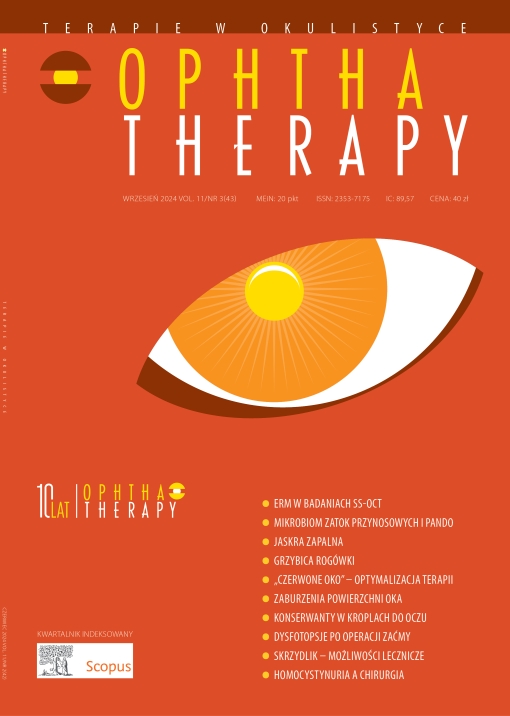A review of conservative and therapeutic management in the treatment of pterygium Review article
Main Article Content
Abstract
Pterygium is a degenerative change consisting of an abnormal overgrowth of the degenerative conjunctiva, which grows on the cornea and causes discomfort and progressive vision problems. The initial symptom of pterygium may also be local, chronic and recurrent conjunctivitis. Some of the most common causes of this disease are exposure to UV radiation, the irritating effect of wind and dust, as well as local insufficiency of limbal stem cells. In the following article, we will discuss the available treatment methods and their impact on the prevention of pterygium recurrence, as well as focus on the pharmacotherapy used to support recovery after surgery.
Downloads
Article Details

This work is licensed under a Creative Commons Attribution-NonCommercial-NoDerivatives 4.0 International License.
Copyright: © Medical Education sp. z o.o. License allowing third parties to copy and redistribute the material in any medium or format and to remix, transform, and build upon the material, provided the original work is properly cited and states its license.
Address reprint requests to: Medical Education, Marcin Kuźma (marcin.kuzma@mededu.pl)
References
2. Zagórski Z, Naumann GOH, Watson P. Choroby rogówki, twardówki i powierzchni oka. Wyd. Czelej, Lublin 2012.
3. Baheran SS, Alany RG, Schwikkard S et al. Pharmacological treatment strategies of pterygium: Drugs, biologics, and novel natural products. Drug Discov Today. 2023; 28(1): 103416. https://doi.org/10.1016/j.drudis.2022.103416.
4. Spaeth GL, Danesh-Meyer HV, Goldberg I et al. Chirurgia okulistyczna. Edra Urban & Partner, Wrocław 2016.
5. Xu W, Jin L, Zhu PZ et al. Implementation and Application of an Intelligent Pterygium Diagnosis System Based on Deep Learning. Front Psychol. 2021; 12: 759229. https://doi.org/10.3389/fpsyg.2021.759229.
6. Niżankowska HM. Okulistyka. Podstawy kliniczne. Wydawnictwo Lekarskie PZWL, Warszawa 2007: 164-165.
7. Liu J, Xu JH, Xu W et al. Bevacizumab as adjuvant therapy in the management of pterygium: a systematic review and Meta-analysis. Int J Ophthalmol. 2017; 10(7): 1126-33. https://doi.org/10.18240/ijo.2017.07.17.
8. Palewski M, Budnik A, Konopińska J. Evaluating the Efficacy and Safety of Different Pterygium Surgeries: A Review of the Literature. Int J Environ Res Public Health. 2022; 19: 11357. https://doi.org/10.3390/ijerph191811357.
9. Shahraki T, Arabi A, Feizi S. Pterygium: an update on pathophysiology, clinical features, and management. Ther Adv Ophthalmol. 2021; 13: 25158414211020152. http://doi.org/10.1177/251584142110201.52.
10. Kaufman SC, Jacobs DS, Lee WB et al. Options and Adjuvants in Surgery for Pterygium. Ophthalmology. 2013; 120(1): 201-8. https://doi.org/10.1016/j.ophtha.2012.06.066.
11. Rosen R. Amniotic Membrane Grafts to Reduce Pterygium Recurrence. Cornea. 2018; 37(2): 189-93. http://doi.org/10.1097/ICO.0000000000001407.
12. AAO. Treating Pterygium: Innovation from Australia - American Academy of Ophthalmology.
13. Mednick Z, Boutin T, Einan-Lifshitz A et al. Simple limbal epithelial transplantation for recurrent pterygium: A case series. Am J Ophthalmol Case Rep. 2018; 12: 5-8.
14. Cholewa D, Mazur R, Wylęgała E. Leczenie niewydolności rąbkowych komórek macierzystych – aktualny stan wiedzy. Magazyn Lekarza Okulisty. 2019; 13(4): 191-202.
15. Oliva-Biénzobas V, Nava-Castañeda A, Jimenez-Corona A et al. Comparison of mini-simple limbal epithelial transplantation and conjunctival-limbal autograft for the treatment of primary pterygium: a randomised controlled trial. Br J Ophthalmol. 2023; 107(12): 1776-81. http://doi.org/10.1136/bjo-2021-320707.
16. Mutlu SN, Evereklioglu C, Najafi J et al. Transparent intrastromal corneal lenticule obtained from SMILE surgery as a free graft for the treatment of primary pterygium: A pilot study. Am J Ophthalmol Case Rep. 2023; 32: 101897. https://doi.org/10.1016/j.ajoc.2023.101897.
17. Śliwiak D. Metody leczenia skrzydlika – od postępowania zachowawczego po operacyjne. Okulistyka po Dyplomie. 2023; 13: 8-14.

